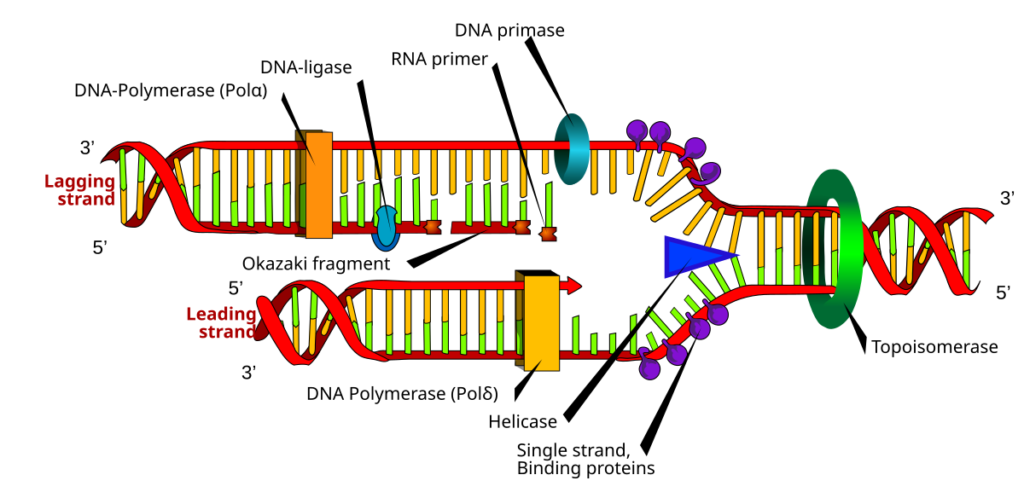
dna polymerase 1
Introduction to DNA Polymerase I
dna polymerase 1 DNA Polymerase I (Pol I) is one of the most significant enzymes in molecular biology, often referred to as the “workhorse” of DNA replication. This enzyme plays a crucial role in maintaining the integrity and continuity of genetic information by ensuring accurate DNA replication. Discovered by Arthur Kornberg in 1956, DNA polymerase I was the first DNA polymerase to be identified, and its functions have since paved the way for a deeper understanding of cellular replication processes.
In this article, we’ll take a deep dive into the world of DNA polymerase I. We’ll cover everything from its discovery and structural makeup to its essential functions in DNA replication, repair, and its applications in biotechnology. Whether you’re familiar with molecular biology or you’re new to the topic, this guide will give you a comprehensive look at why DNA Polymerase I remains an enzyme of immense importance in biological science.
Understanding this enzyme not only provides insight into fundamental life dna polymerase 1 processes but also highlights its utility in scientific research and medical advancements. Let’s explore the diverse aspects of DNA polymerase I and why it’s indispensable to both life and science.
The Discovery of DNA Polymerase I: A Milestone in Molecular Biology

The story of DNA polymerase I begins in the mid-20th century when scientists were striving to understand how DNA replicates. Before its discovery, scientists knew DNA dna polymerase 1was the genetic material, but the mechanics of its replication were still a mystery. In 1956, Arthur Kornberg, a biochemist, made a groundbreaking discovery by isolating an enzyme capable of synthesizing DNA, which he named DNA Polymerase I.
Kornberg’s work earned him a Nobel Prize in 1959, and his discovery dna polymerase 1 opened the floodgates for research on DNA replication and repair mechanisms. DNA Polymerase I was initially thought to be the primary enzyme responsible for DNA replication in Escherichia coli (E. coli) and other prokaryotic cells. While later studies revealed that other polymerases, like DNA Polymerase III, play a more central role in replication, DNA Polymerase I remains crucial for several key cellular processes.
The discovery of DNA Polymerase I was not just about dna polymerase 1 identifying an enzyme—it was the beginning of molecular biology as we know it today. Kornberg’s work laid the foundation for understanding the molecular machinery behind DNA replication, which is central to everything from genetics to cancer research.
Structure of DNA Polymerase I: A Look at Its Molecular Anatomy
DNA Polymerase I has a unique structure that allows it to perform multiple functions. Structurally, it is a single polypeptide with several distinct domains, each of which contributes to the enzyme’s activity. These domains are often referred to as the polymerase domain, exonuclease domain, and the 5′ to 3′ exonuclease domain, all of which work in tandem to ensure DNA is replicated with high fidelity.
The polymerase domain is responsible for the enzyme’s DNA synthesis dna polymerase 1 activity, adding nucleotides to the growing DNA strand. This part of the enzyme has a shape reminiscent of a hand, where the “fingers” grab the incoming nucleotides, the “palm” holds the DNA template, and the “thumb” helps stabilize the interaction between the enzyme and the DNA strand.
The exonuclease domains provide proofreading functions. The 3′ to 5′ dna polymerase 1 exonuclease domain removes incorrectly added nucleotides, enhancing the accuracy of DNA replication. Without this domain, DNA replication would be prone to errors, leading to mutations.
Interestingly, DNA Polymerase I also possesses a 5′ to 3′ exonuclease activity, dna polymerase 1 which is crucial during the DNA repair process. This domain allows the enzyme to remove RNA primers and replace them with DNA, a vital step in the replication process. The structure of DNA Polymerase I is perfectly designed for these tasks, ensuring that DNA synthesis is both accurate and efficient.
Functions of DNA Polymerase I: More than Just DNA Synthesis
While DNA Polymerase I was initially thought to be the key enzyme in DNA dna polymerase 1 replication, its roles have expanded to include other essential functions within the cell. Although DNA Polymerase III is the primary enzyme responsible for the replication of bacterial genomes, DNA Polymerase I plays critical supporting roles.
1. Lagging Strand Synthesis
During DNA replication, the enzyme fills in the gaps left behind by dna polymerase 1 RNA primers on the lagging strand. DNA replication is semi-discontinuous, meaning that while one strand (the leading strand) is synthesized continuously, the other strand (the lagging strand) is synthesized in short fragments known as Okazaki fragments. RNA primers are used to initiate the synthesis of these fragments, but they must eventually be removed and replaced with DNA. DNA Polymerase I performs this task with its 5′ to 3′ exonuclease activity, which removes the RNA primers, and its polymerase activity, which fills the gaps with DNA.
2. DNA Repair
DNA Polymerase I is also involved in DNA repair processes, particularly in excision repair pathways. It helps remove damaged or mismatched nucleotides and replaces them with the correct ones. This function is critical for maintaining the integrity of the genome and preventing mutations that could lead to diseases such as cancer.dna polymerase 1DNA Polymerase I is also involved in DNA repair processes, particularly in excision repair pathways. It helps remove damaged or mismatched nucleotides and replaces them with the correct ones. This function is critical for maintaining the integrity of the genome and preventing mutations that could lead to diseases such as cancer.
3. Proofreading
One of the most important functions of DNA Polymerase I is dna polymerase 1 its proofreading ability. As mentioned earlier, the enzyme has a 3′ to 5′ exonuclease activity that allows it to remove incorrectly incorporated nucleotides. This ensures that errors made during DNA replication are corrected, reducing the likelihood of mutations.
Through these functions, DNA Polymerase I helps ensure the dna polymerase 1 fidelity and accuracy of DNA replication. It may not be the main player in replicating the genome, but without it, the process would be far more error-prone and less efficient.
DNA Polymerase I in Biotechnology: A Tool for Scientists
The versatility of DNA Polymerase I extends beyond its natural dna polymerase 1 role in cells. Scientists have harnessed its abilities for various applications in molecular biology and biotechnology. DNA Polymerase I, and more specifically its derivatives like the Klenow fragment, have been integral tools in DNA manipulation and amplification.
1. DNA Sequencing
One of the earliest applications of DNA Polymerase I in biotechnology was in dna polymerase 1 DNA sequencing. The Klenow fragment of DNA Polymerase I, which lacks the 5′ to 3′ exonuclease activity, was used in the chain termination method of DNA sequencing developed by Frederick Sanger. This method, also known as Sanger sequencing, became the standard for DNA sequencing for many years, helping to decode the human genome.
2. Polymerase Chain Reaction (PCR)
Although DNA Polymerase I is not typically used in PCR, its discovery dna polymerase 1 paved the way for the development of other thermostable polymerases, like Taq polymerase, which are used in PCR. The ability of DNA polymerases to synthesize new DNA strands has made PCR one of the most essential techniques in molecular biology, used for everything from gene cloning to forensic analysis.
3. Cloning and Gene Manipulation
DNA Polymerase I and its derivatives are also used in cloning and gene manipulation techniques. For example, the Klenow fragment is often used to fill in overhangs in DNA fragments, preparing them for ligation into vectors. This makes DNA Polymerase I an essential tool for recombinant DNA technology, which has applications in fields like medicine, agriculture, and biotechnology.
The Klenow Fragment: A Derivative with Unique Applications
One of the most famous derivatives of DNA Polymerase I is the Klenow fragment, dna polymerase 1 named after H. Klenow, who discovered it. The Klenow fragment is a large fragment of DNA Polymerase I that retains the polymerase and proofreading activities but lacks the 5′ to 3′ exonuclease activity.
The Klenow fragment has found widespread use in molecular biology laboratories. Its ability to synthesize DNA without degrading the template makes it useful for a variety of applications, including:
- Filling in 3′ overhangs to create blunt-ended DNA for cloning
- DNA labeling using radioactive or fluorescent nucleotides
- Random priming for DNA sequencing and hybridization studies
The versatility of the Klenow fragment exemplifies how derivatives of DNA Polymerase I have been adapted for specialized tasks in the laboratory.
DNA Polymerase I and Its Role in Bacterial Cells
In bacteria like E. coli, DNA Polymerase I plays a vital role in both DNA replication and repair. Its 5′ to 3′ exonuclease activity allows it to remove RNA primers during the replication process, while its polymerase activity fills in the gaps with DNA.
However, DNA Polymerase I’s functions are not limited to replication. It is also involved in several repair pathways, including base excision repair and nucleotide excision repair. These pathways are essential for correcting damaged or mismatched bases in the DNA, ensuring the stability of the bacterial genome.
One of the reasons DNA Polymerase I is so important in bacterial cells is that they do not have the same sophisticated repair mechanisms as eukaryotic cells. Therefore, DNA Polymerase I’s ability to remove and replace damaged nucleotides is critical for the survival of the bacterium, particularly under stressful conditions like exposure to UV light or harmful chemicals.
DNA Polymerase I in Eukaryotes: What’s the Equivalent?
While DNA Polymerase I is a key player in bacterial cells, eukaryotic cells (such as those in humans) rely on a different set of DNA polymerases for replication and repair. DNA Polymerase I itself does not have a direct equivalent in eukaryotes, but its functions are divided among several other enzymes.
For instance, DNA Polymerase δ and DNA Polymerase ε are responsible for synthesizing the leading and lagging strands during replication in eukaryotes.





